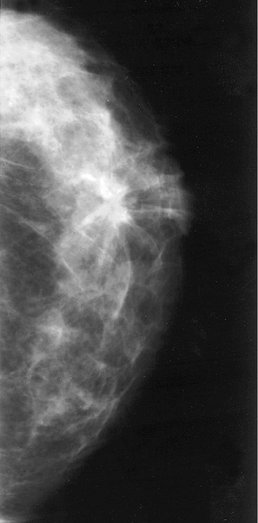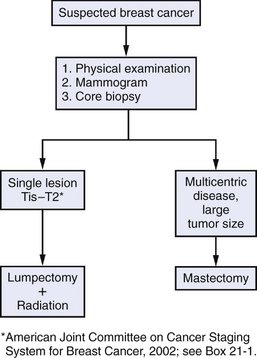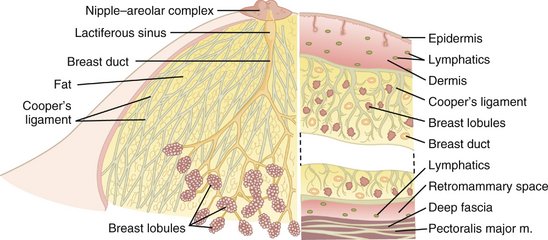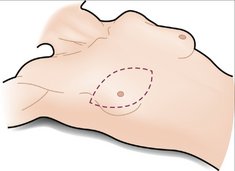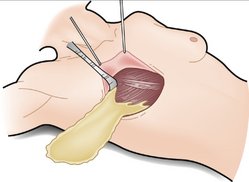CHAPTER 21 Mastectomy
Case Study
A mammogram is obtained, which shows a stellate mass in the right breast (Fig. 21-1). A core needle biopsy is obtained and shows poorly differentiated invasive ductal carcinoma.
BACKGROUND
Breast cancer is the most common malignancy in women, excluding cancers of the skin. Fortunately, the majority of breast cancers are diagnosed as early-stage lesions and are therefore amenable to surgical intervention with good anticipated outcomes (for current staging, see Box 21-1). The surgical management of breast cancer has undergone a dramatic transformation over the past several decades. Until the mid-1970s, radical mastectomy, a procedure that involved removal of breast tissue, the underlying pectoralis muscles, and regional axillary nodes, was the procedure of choice for the treatment of breast cancers. This operation was subsequently replaced by the modified radical mastectomy (which spares the pectoralis muscles) and the total or simple mastectomy (a pectoralis-sparing mastectomy without axillary lymphadenectomy). Over the past 2 decades, breast-conserving therapy, consisting of partial mastectomy (lumpectomy) and radiation therapy, has assumed a prominent role in the treatment paradigm for increasing numbers of breast cancers. More recently, sentinel lymph node biopsy has greatly reduced the number of axillary lymph node dissections performed on patients without clinically evident nodal metastases.
BOX 21-1
Joint Committee on Cancer Staging System for Breast Cancer
TNM Definitions
Primary Tumor (T)
Regional Lymph Nodes (N)
From Singletary SE, Allred C, Ashley P, et al: Revision of the American Joint Committee on Cancer staging system for breast cancer. J Clin Oncol 20:3628–3636, 2002. Reprinted with permission from the American Society of Clinical Oncology.
This chapter focuses on partial mastectomy and total mastectomy, which remain important components of the management of in situ and invasive breast cancers. Sentinel lymph node biopsy is addressed in detail in Chapter 23, as is axillary lymphadenectomy, which is sometimes performed in conjunction with total mastectomy.
INDICATIONS FOR MASTECTOMY
PREOPERATIVE EVALUATION
COMPONENTS OF THE PROCEDURE AND APPLIED ANATOMY
Preoperative Considerations
Patient Positioning and Preparation
Partial Mastectomy
Total Mastectomy
Iglehart JD, Kaelin CM. Diseases of the breast. In: Townsend CM, Beauchamp RD, Evers BM, Mattox KL, editors. Sabiston Textbook of Surgery: The Biological Basis of Modern Surgical Practice. 17th ed. Philadelphia: Saunders; 2004:867-927.
Roses DF, Giuliano AE. Surgery for breast cancer. In: Roses DF, editor. Breast Cancer. 2nd ed. Philadelphia: Churchill Livingstone; 2005:401-460.
Singletary SE, Allred C, Ashley P, et al. Revision of the American Joint Committee on Cancer staging system for breast cancer. J Clin Oncol. 2002;20:3628-3636.

